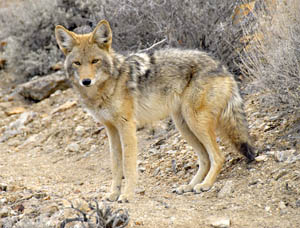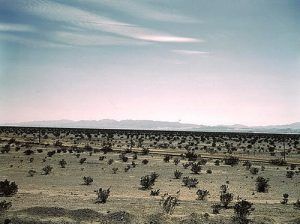By William Daugherty in 1891
It was 18 years ago that this writer first viewed the Mojave Desert from the eastern outlet of Walker’s Pass through the Sierra Mountains. Being familiar with the characteristics of this intermountain region, it was not a matter of many surprises to look upon the sterility presented. Still, coming through an interesting section of the Sierras, past well-cultivated farms and through lands of fertility and productiveness, the first sight of the desert exhibited such a striking contrast that the change was duly noted in the diary that was a constant companion in travel, and referring to it now revives memories of that lonely ride. The view was noted in the following words:
Nearing the canyon’s mouth on the eastern slope, a change was noted in the air and climate, the roads, and the surroundings. It was no longer California. Instead of the giant oaks of the western slope, with the glades’ rushes and grasses, the eye rested upon bare hills, stunted sagebrush, and occasional specimens of the grim and forbidding bayonet cactus.
No rills nor rivulets of crystal waters, but dry, sandy washes instead, with the slate pebbles glistening like bleached bones in the desert. The road changed from a springy alluvium bed to the grating, rasping sands that nature had seemingly left unfinished centuries ago. One felt at once the presence of the sterile desolation of the Mojave Desert, which grim and silent stretched away into the hazy distance toward the Colorado River, the land of cactus and Apache, which lures lost wanderers to an unknown fate. Right there should be written Dante’s inscription, “Who enters here leaves hope behind.”
The moon was rising through a misty haze directly ahead, and the specter-like shadows of distant mountains stretched in wavering lines across the gray surface of the desert, in startling imitation of gentle, rippling water. If ever the expression “still life” was appropriate, it seemed, at that instant, a vivid reality. And in the midst of what was a most entrancing sight, there suddenly appeared an army of grim sentinels that looked like headless men, with outstretched arms rising in rigid silence out of the earth, all around and beyond us. It was as weird and ghostly a spectacle as ever the eye-witnessed, and it required a neater approach and closer inspection to solve the mysterious scene. We had emerged from the canyon, just at the rising of the moon, into the midst of a forest of bayonet cactus. They grow the same size from the root to the tips of the few branches that stand out from the main trunk like the arms of gibbets, and which give them, in the moonlight, the looks of hideous, headless monsters. The picture of Plutonian deviltry was increased by the shadowy movements of vagabond coyotes gliding in silent stealth through the ghostly forest. And when informed that this section was then the favorite rendezvous of the Mexican bandit, Chavez and his gang, who roamed from here to Elizabeth Lake, and toward Los Angeles, it quickened the pulse and banished sleep for the remainder of that night’s ride. Since then, the cactus forest has been located, to make it into paper by the usual process, and what seemed to us a spot of weird romance, is to be converted into prosy fact.
By William Daugherty, for the Reno Evening Gazette, March 14, 1891. Compiled and edited by Kathy Weiser/Legends of America, updated January 2021.
About the Author: Written by William Daugherty wrote for the Reno Evening Gazette in 1891. The Gazette was first published on October 12, 1876, and continued for the next 107 years. In 1977, it was merged with the Nevada State Journal and continues to exist today as the Reno Gazette-Journal.
Note: The article is not verbatim as spelling errors, minor grammatical changes, and editing have occurred for the ease of the modern reader.
Also See:
Pioneers on the Nevada Frontier (Reno Evening Gazette)
Tales of the Overland Stage (Reno Evening Gazette)
Nevada Mining Tales (Reno Evening Gazette)


